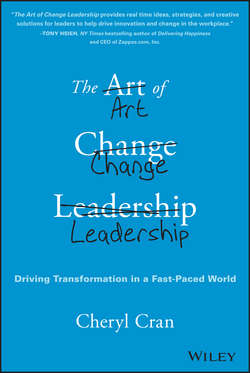Читать книгу The Art of Change Leadership - Cheryl Cran - Страница 5
На сайте Литреса книга снята с продажи.
Preface
The Art of Change Leadership – Driving Transformation in a Fast-Paced World
ОглавлениеThe only thing that is constant is change.
– Heraclitus
How has your life changed in the past five years?
How has your workplace changed in the past five years?
Collectively there has been more change in the past five years than previous generations experienced in a lifetime!
In the spring of 2010 my book, 101 Ways to Make Generations X, Y and Zoomers Happy at Work, was published. It was based on client research with dozens of organizations in North America who were asking, “What is with the younger generations?” and, at that time, the generations' impact was seen as one of the biggest forces of change. My generations research and work with clients produced significant transformations as they applied to reorganizing, elevating leadership capability, and enhancing cultural renewal and business growth.
In 2012 my next book released was the popular Leadership Mastery in the Digital Age, which was based on the fact that it was not just the generations that were causing massive change in organizations; rather, it was in a big way the technological revolution. Technology was and is creating massive upheaval. It continues to evolve quickly and this impacts employees' abilities to keep up and provide speedy customer delivery. Technology has given customers access to information and technology has a major impact on increasing global competition.
I have worked with hundreds of clients globally in diverse industries such as technology, insurance, finance, manufacturing, healthcare, and more, and I have helped leaders to integrate the change-cycle model into their strategy to drive transformation. Thus, this book was born.
You might be asking, why this book and why now?
In this book I build on the strategies and virtues of the two previous books and provide a holistic plan to lead change and drive transformation in a fast-paced world. I use the word holistic to expand the perceptions around change beyond how it is currently viewed. Many leaders and organizations hear the word change and they balk because it implies that what they are doing right now isn't working. Shifting the word to transformation helps and yet there are many who are still afraid of the implications of change with fears such as “something has to go” (me/my job/my autonomy/my identity/my company).
A holistic approach to change and transformation comes from the positive assumption that what you have done as a leader and as an organization and what you are currently doing have been and are already successful. In addition, there is a realization that you must be open and build on the successes of the past; you must include all stakeholders in the new vision/direction of what is possible; and, rather than focus on eliminate or lose, you focus on reinventing, re-creating, and reorganizing the entire system. The holistic approach is inclusive and all is seen as an ally: all people, all systems, all products, all customers, and you focus on including all while building renewed strategies and approaches.
My mission is to massively shift the view and approach to transformation away from “something or someone has to lose” and toward “everyone has something to gain.” This book is not about change management; it is about creating organizational cultures with change leaders.
This book progresses from the I to the we and begins with the compelling reasons that your change leadership and transformation abilities are needed right now. It moves through the concept that only by adding value and sharing value can we authentically and abundantly seek to create changes that benefit the greater system (you, your team, the company, your industry, and the world).
I present research and information that confirms that there are tools that include mindfulness and emotional intelligence that can speed the pace of individual and collective transformation.
Clarification is given on the difference between a change manager and a change leader and why an integration of the skills of each is needed in this rapidly changing era.
The subject of technology appears throughout the book and indicates the massive opportunity to leverage existing technology knowledge within organizations in order to speed up the rate of innovation.
I share holistic thought leaders' overviews of the power of harnessing the energy of people to lead change and to empower those same people to become more effective leaders of change.
The change-cycle model is examined and is used as a reference tool for you to check yourself as a change leader, where you are in the cycle, and as a check-up tool for your organization.
I review the current and up-to-date research on the generations as it relates to the global changes affecting business today and ideas on how to integrate the strengths of all the generations to drive transformation.
The three-step change model simplifies the key areas of leading change and provides a guideline for project management of change initiatives.
Last, a leadership survey of over 200 leaders from middle management to C-suite provides further supporting data and insight to the changes affecting organizations, the challenges, and the opportunities for transforming the current workplace into the workplace of the future – today!
As always, it is my clients who have inspired this book. I have tremendous respect and admiration for the leaders I work with, for their courage and their drive toward transformation – and some of their stories are included.
May 2015
Cheryl Cran
